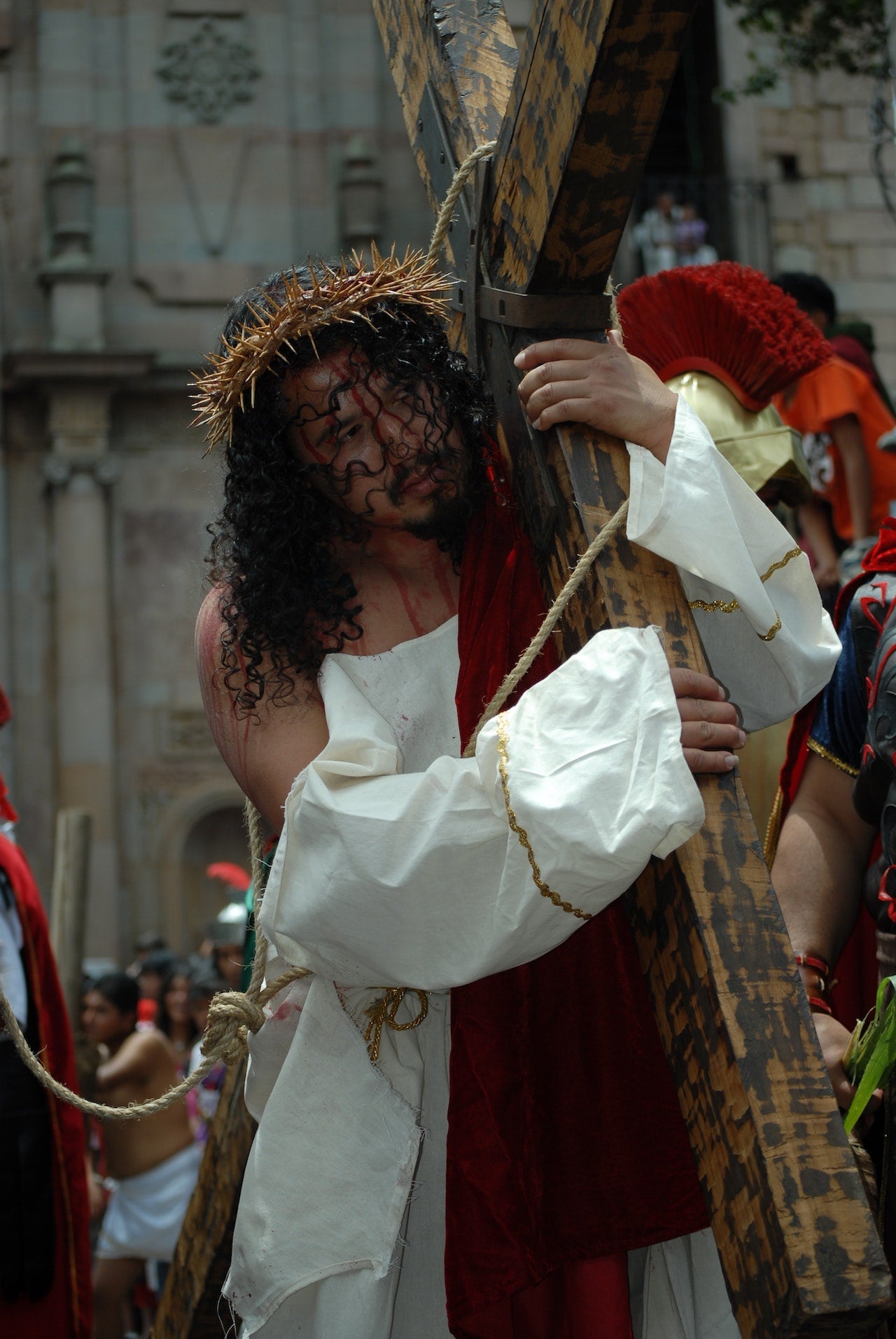
Breaking through the barriers with children, fear, faith, failure, and forgiveness
By Judi M McLaren
One paid for the sins of all.
Lent, a period of 40 days leading up to Easter, is a time of reflection, repentance, and renewal for many Christians worldwide. Traditionally, it has been observed with strict fasting and penance, but modern interpretations have evolved to include a variety of practices that can be meaningful and transformative.
Beginning with the revelry of Mardi ( Tuesday en francais ) Gras and ending on Maundy Thursday, the day in between is symbolic and named Ash Wednesday. Fat Tuesday is seen as a gluttonous free-for-all last chance to get rid of any fats, bad habits, vices, and urges before the beginning of the solemnity of pre-Easter biblical reference. Maundy Thursday is based on the Last Supper of Christ before the crucifixion.
Communion begins with the gathering of the faithful to affirm.
To bring light upon the events that began on Tuesday and perhaps be a cause for unknown fear of the imagery of eating of the flesh and drinking the blood of Jesus along with the length, drunkenness, and over feasting by the Disciples at the Table, lets ponder the biblical retelling of it below as found transcribed in the book of Matthew:
"On the first day of the Feast of Unleavened Bread, the disciples came to Jesus and asked, "Where do you want us to make preparations for you to eat the Passover?" 18 He replied, "Go into the city to a certain man and tell him, 'The Teacher says: My appointed time is near. I am going to celebrate the Passover with my disciples at your house.' "19 So the disciples did as Jesus had directed them and prepared the Passover.
20 When evening came, Jesus was reclining at the table with the Twelve. 21 And while they were eating, he said, "I tell you the truth, one of you will betray me." 22 They were very sad and began to say to him one after the other, "Surely not I, Lord?" 23 Jesus replied, "The one who has dipped his hand into the bowl with me will betray me. 24 The Son of Man will go just as it is written about him. But woe to that man who betrays the Son of Man! It would be better for him if he had not been born." 25 Then Judas, the one who would betray him, said, "Surely not I, Rabbi?" Jesus answered, "Yes, it is you."
26 While they were eating, Jesus took bread, gave thanks and broke it, and gave it to his disciples, saying, "Take and eat; this is my body." 27 Then he took the cup, gave thanks and offered it to them, saying, "Drink from it, all of you. 28 This is my blood of the covenant, which is poured out for many for the forgiveness of sins. 29 I tell you, I will not drink of this fruit of the vine from now on until that day when I drink it anew with you in my Father's kingdom." 30 When they had sung a hymn, they went out to the Mount of Olives."
The day after repentance and humble believers' contributions
So why did the disciples then go and break communion vows by openly betraying and denying being followers of Christ? The marking of the shame of ashes upon the forehead or wrists is now indicative of the chosen to show their penance.
Ash Wednesday, the start of Lent, is symbolized by the imposition of ashes on believers' foreheads. These ashes, traditionally made by burning palm branches from the previous year's Palm Sunday, symbolize mortality and repentance. "Remember that you are dust, and to dust you shall return," the priest says, reminding us of our human frailty and the need for humility.
The final resolution of Maundy Thursday
Luke 22:19-20: "And he took bread, gave thanks and broke it, and gave it to them, saying, "This is my body given for you; do this in remembrance of me." In the same way, after the supper he took the cup, saying, "This cup is the new covenant in my blood, which is poured out for you." crosswalk.com
It was there, in the Garden of Gethsemane, where Jesus made peace within his soul and readied himself to give his last breath in the covenant made with his Holy Father, an ultimate sacrifice for all who chose to devote themselves to all of his ministrations and who vow to become a family of disciples.
Modern approaches to an ancient tradition
To help lighten the dark pall and still give full faith, here are some of the best modern ways to observe the entire period of Lent.
- Fasting and Abstinence: In the past, Lent was a time of strict fasting, with observers eating only one meal a day and abstaining from meat, eggs, and dairy products. Today, many people choose to give up a particular vice or indulgence, such as sweets, alcohol, or social media. This act of self-denial is not just about testing one's willpower but about creating space for more meaningful pursuits and spiritual growth.
- Spiritual Practices: Modern Lent observers often incorporate spiritual practices into daily routines. This could include prayer, meditation, reading spiritual texts, or attending religious services. These practices can help individuals connect more deeply with their faith and the meaning of Lent.
- Acts of Kindness: Many people focus on acts of kindness and charity during Lent. This could involve volunteering at a local charity, donating to a cause, or simply making an effort to be kinder and more compassionate in daily interactions. While Lent is primarily observed by Catholics, it is not exclusive to them. Many Protestant denominations also observe Lent and even non-Christians can participate in the spirit of the season by using it as a time of self-reflection and personal growth.
Lent, children, and path to giving, not expecting.
Growing up, one of my most favorite holiday celebrations was the Easter break. It was full of reasons to look forward to it. We got a week off school, the weather allowed us to play outside without heavy coats and snow-frosted mittens, television broadcasts of treasured movie classics gave us reason to stay up late, and of course, there was the food. Oh, and I would, of course, be remiss in mentioning the overindulgence gifts of chocolate galore and at least two brand new trendy outfits of clothing. All of this bounty, and all we had to do was go to church? Count me in!
Until I reached a certain age of religious discovery when I realized that all of this was paid for by the blood, pain, and agony of one man being nailed on a cross, torn, fleshed, emaciated, bones broken, and left alone to suffer in anguish for three whole days. Somehow, the chocolate didn't seem as sweet anymore. This was a holiday built on fear and death. Or so I thought.
Jump ahead, and now most children come to see Easter as a day of receiving and expecting, indulging in sweets, toys, and electronics, and spending free time with those trinkets without having to be connected in any family or peer involvement.
Explaining Lent to children: helping kids overcome fear and choose faith over chocolate
The religious reasons and images associated with Lent, such as fasting, prayer, and the crucifixion, can be daunting and even scary for young minds. However, it's essential to remember that Lent isn't about fear; it's about reflection, repentance, and preparation for Easter.
Children's fear of Lent can stem from various sources. The solemnity of the season, the emphasis on sin and repentance, and the graphic images of Christ's suffering and death can be intimidating. Moreover, the commercialization of Easter, focusing on bunnies and eggs, can confuse children about the season's true meaning.To help encourage understanding and participation by a child, you can:
- Simplify the Concept: Start by explaining Lent in simple terms. You can say it's a time when Christians prepare for Easter by praying more, doing good deeds, and sometimes giving up something they like.
- Use Age-Appropriate Resources: Many children's books and videos explain Lent and Easter in a kid-friendly way. These resources can help children understand the season without fear.
- Focus on Positive Aspects: Instead of focusing on sin and punishment, emphasize the positive aspects of Lent, such as love, forgiveness, and the joy of Easter.
- Encourage Questions: Let your child ask questions about Lent and Easter. Answer them honestly but in a way that is appropriate for their age and understanding.
Easier said than done, but the mere attempts will eventually gain a strong foothold, and soon, your child will have firm foundations upon which to base their own religious discoveries as they grow. Start off with some ideas that include:
- Lenten Calendar: Create a Lenten calendar with your child, marking each day with a good deed or prayer. This can help them understand the concept of sacrifice and service during Lent.
- Storytelling: Share stories from the Bible that emphasize love, forgiveness, and sacrifice. This can help children understand the themes of Lent in a more relatable way.
- Art and Craft: Encourage your child to draw or craft something related to Lent. This could be a cross, a heart, or even a scene from a Bible story. This activity can help children express their understanding and feelings about Lent.
- Prayer Time: Set aside a special time each day for prayer with your child. This can help them understand the importance of prayer during Lent.
- Head out to a church service
++ tips and trivia++ Did you know that the Easter Egg symbology stems from the word ova for shape and egg; and Oestre is associated with The Goddess of Spring and Fertility as is seen when we replant seeds of replenishment either in garden or by birth?
Rising above failure during lent
Worldwide, when believers commit to fasting, prayer, and acts of service designed to mirror Jesus Christ's affirmation of ascension, a 40-day fast in the wilderness after his resurrection, there are times when we may falter in our commitments, leading to feelings of failure. If you find yourself in this situation, some of the best ways to help you cope with this include having the humble strength to
1. Acknowledge Your Shortcomings:
The first step in dealing with failure is acknowledging it. It's okay to admit you've fallen short of your Lenten commitments. Remember, Lent is not about perfection but about spiritual growth and transformation. Recognizing your shortcomings is a sign of humility and the first step towards repentance.
2. Seek Forgiveness:
Once you've acknowledged your failure, the next step is to seek forgiveness. Depending on your denomination's practices, this can be done through prayer or confession. Remember, God is merciful and forgiving. He understands our human frailties and is always ready to forgive us when we genuinely repent.
3. Reflecting and Learning:
Failure can be a powerful teacher if we allow it. Reflect on why you failed. Was it due to a lack of planning and discipline, or was it a moment of weakness? Understanding the reasons behind your failure can help you learn from it and avoid repeating the same mistakes.
4. Recommit to Your Lenten Promise:
Just because you've failed once doesn't mean you should give up on your Lenten promise. Use your failure as a steppingstone to recommit to your promise with renewed vigor and determination. Remember, the goal of Lent is to draw closer to God, and every step, no matter how small, brings you closer to this goal.
5. Seek Support:
If you're finding it hard to stick to your Lenten commitments, consider seeking support from your faith community. This could be your local church, a spiritual mentor, or a prayer group. Sharing your struggles with others can provide encouragement, accountability, and practical advice.
6.Practice Self-Compassion:
Lastly, be kind to yourself. Everyone stumbles and falls at times. Instead of beating yourself up over your failure, practice self-compassion. Remind yourself that you're human and that God's love for you is not dependent on your performance.
Observing Lent in the modern world can be a deeply personal and transformative experience. Whether you choose to fast, engage in spiritual practices, perform acts of kindness, or a combination of these, the key is to find a practice that resonates with you and helps you reflect on your faith and values. Remember, Lent is a time to foster faith, love, and understanding.







